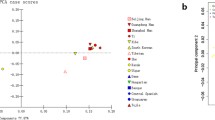Summary
Four kinds of DNA probes that recognize hypervariable regions (HVR) were studied for parentage testing and individual identification. Allele frequencies and their confidence intervals among unrelated Japanese individuals were obtained. Codominant segregation of the polymorphism was confirmed in family studies. Two a priori probabilities were calculated for each HVR locus: the exclusion probabilities for an alleged father/mother/ child trio and for an alleged parent/child duo, and the probabilities of matching of genotypes of two unrelated individuals or two siblings. The ease of availability of the probes and their highly discriminating polymorphic patterns mean they could be very useful for forensic purposes.
Zusammenfassung
Es wird eine Analyse der Polymorphismen von 4 hypervariablen Gebieten (HVR, hypervariable region) von 4 verschiedenen DNA-Polymorphismen zur Vaterschaftsfeststellung und zu Identifizierungszwekken vorgenommen. Die Allelfrequenzen und die Konfidenz-Intervalle zwischen unverwandten Japanern werden angegeben. Der co-dominante Erbgang des Polymorphismus wurde durch Familienuntersuchungen bestätigt. Zwei a priori-Wahrscheinlichkeiten wurden für jeden HVR-Locus errechnet: Die Ausschlußwahrscheinlichkeiten für ein Putativ-Terzett „Vater/Mutter/ Kind“ und für ein Putativ-Duo „Eltern/Kind“. Außerdem wurden die Wahrscheinlichkeiten für eine genotypische Übereinstimmung zwischen zwei unverwandten Personen oder zwischen zwei Geschwistern errechnet. Die Zugänglichkeit der Proben und die hochgradig diskriminierenden polymorphen Muster machen die untersuchten Systeme sehr brauchbar für forensische Zwecke.
Similar content being viewed by others
References
Copper DN, Schmidtke J (1984) DNA restriction fragment length polymorphisms and heterozygosity in the human genome. Hum Genet 66:1–16
Nakamura Y, Lathrop M, O'Connell P, Leppert M, Barker D, Wright EW, Skolnick M, Kondoleon S, Litt M, Lalouel JM, White R (1988) A mapped set of DNA marker for human chromosome 17. Genomics 2:302–309
Nakamura Y, Lathrop M, O'Connell P, Leppert M, Lalouel J-M, White R (1988) A mapped set of DNA markers for human chromosome 15. Genomics 3:342–346
Jeffreys AJ, Brookfield JEY, Semenoff R (1985) Positive identification of an immigration test-case using human DNA fingerprints. Nature 317:818–819
Baird M, Balazs I, Giusti A, Miyazaki L, Nicholas L, Wexler K, Kanter E, Glassberg J, Allen F, Rubinstein P, Sussmann L (1986) Allelic frequency distribution of two highly polymorphic DNA sequences in three ethnic groups and its application to the determination of paternity. Am J Hum Genet 39:489–501
Jeffreys AJ, Wilson V, Thein SL (1985) Individualspecific ‘fingerprints’ of human DNA. Nature 316:76–79
Gill P, Jeffreys AJ, Werrett DJ (1985) Forensic application of DNA ‘fingerprint’. Nature 318:577–579
Giusti A, Baird M, Pasquale S, Balazs I, Glassberg J (1986) Application of deoxyribonucleic acid (DNA) polymorphisms to the analysis of DNA recovered from sperm. J Forensic Sci 31:409–417
Nakamura Y, Leppert M, O'Connell P, Woff R, Holm T, Culver M, Martin C, Fujimoto E, Hoff M, Kumlin E, White R (1987) Variable number of tandem repeat (VNTR) markers for human gene mapping. Science 235:1616–1622
Maniatis T, Fritsch EF, Sambrook J (1982) Molekular cloning. A laboratory manual. Cold Spring Harbor Laboratory, Cold Spring Harbor, NY
Higgs DR, Goodbourn SEY, Wainscoat JS, Clegg JB, Weatherall DJ (1981) Highly variable regions of DNA flank the human alpha globin genes. Nucleic Acids Res 9:4213–4224
Capon DJ, Chen EY, Levinson AD, Seeburg PH, Goeddel DV (1983) Complete nucleotide sequences of the T24 human bladder carcinoma oncogene and its normal homologue. Nature 302:33–37
Gendler SJ, Burchell JM, Duhig T, Lamport D, White R, Parker M, Taylor-Paradimitriou J (1987) Cloning of partial cDNA encoding differentiation and tumor-associated mucin glycoproteins expressed by human mammary epithelium. Proc Natl Acad Sci USA 84:6060–6064
Hartley JL, Gregori TJ (1981) Cloning multiple copies of a DNA segment. Gene 13:347–353
Elandt-Johnson RC (1971) Probability models and statistical methods in genetics. Wiley, New York
Ohno Y, Sebetan IM, Akaishi S (1982) A simple method for the probability of excluding paternity with any number of codominant alleles. Forensic Sci Int 19:93–98
Selvin S (1980) Probability of nonpaternity determined by multiple allele codominant systems. Am J Hum Genet 32:276–278
Garber RA, Morris JW (1981) General equations for the average power of exclusion for genetic systems of n codominant alleles in one-parent and no-parent cases of disputed parentage. In: Walker RH (ed) Inclusion probabilities in parentage testing. American Association of Blood Banks, Arlington, pp 277–280
Gill P, Lygo JE, Fowler SJ, Werrett DJ (1987) An evaluation of DNA fingerprinting for forensic purposes. Electrophoresis 8:38–44
Jeffreys AJ, Wilson V, Thein SL, Weatherall DJ, Ponder BAJ (1986) DNA “fingerprints” and segregation analysis of multiple markers in human pedigrees. Am J Hum Genet 39:11–24
Reeders ST, Breuning MH, Devies KE, Nicholls RD, Jarman AP, Higgs DR, Pearson PL, Weatherall DJ (1985) A highly polymorphic DNA marker linked to adult polycystic kidney disease on chromosome 16. Nature 317:542–544
Allen RW, Bliss B, Pearson A (1989) Characteristics of a DNA probe (pa3′HVR) when used for paternity testing. Transfusion 29:477–485
Yokoi T, Nata M, Odaira T, Sagisaka K (1990) Hypervariable polymorphic VNTR loci for parentage testing and individual identification. Jpn J Hum Genet (in press)
Balazs I, Baird M, Clyne M, Maede E (1988) Human population genetic studies of five hypervariable DNA loci. Am J Hum Genet 44:182–190
Jeffreys AJ, Royle NJ, Wilson V, Wong Z (1988) Spontaneous mutation rates to new length alleles at tandem repetitive hypervariable loci in human DNA. Nature 332:278–281
Wainscoat JS, Pilkington S, Peto TEA, Bell JI, Higgs DR (1987) Allele-specific DNA identity patterns. Hum Genet 75:384–387
Author information
Authors and Affiliations
Rights and permissions
About this article
Cite this article
Yokoi, T., Nata, M., Odaira, T. et al. Hypervariable regions of DNA for parentage testing and individual identification. Z Rechtsmed 103, 487–497 (1990). https://doi.org/10.1007/BF01254400
Received:
Issue Date:
DOI: https://doi.org/10.1007/BF01254400




